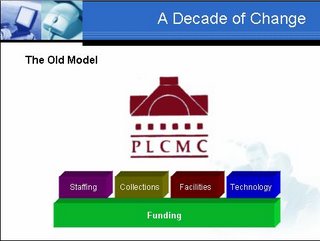

Because of the implementation, support and use of technology, our staffs are more skilled and highly trained. And when the network goes down or there is a strain in the infrastructure backbone, it cripples our ability to provide full services.
Because of the use of technology, our collections are accessible to more people (from home, work or anywhere), our materials move faster to and from the patrons hands and we are better able to develop exciting and diverse collections to meet our growing public’s demand and need.
Because of the use of new technologies, our buildings and facilities are better managed, smarter in design to deliver services and capable of adapting more easily to service level changes.
So if your library is still treating technology as a separate service offering or silo, step back and think about this. What would you do …
… if you lost email communications for week because your server crashed and hadn’t been upgraded in 5 years?
… if all your access to electronic databases and the internet went down for a week because your network (built on a fragile spider web of routers, switches and equipment) failed and was as old as that first PC -- remember those PCs that booted from 5 1/4” floppies and had 10 mb hard drives – your library installed?
… if access to your online catalog evaporated along with a nasty virus attack that rendered your database useable?
… if you had no way to check-in or scan returned materials so you could get them back on the shelves or forwarded to the next patron in line?
The truth is technology is core to nearly everything we do, from checking out books and materials to answering simple reference questions; to communication with our staffs and public; to providing access to our buildings and facilities; and most especially, to our core services.
I agree with Roy... Technology is NOT a service. Technology IS an ever-evolving FOUNDATION.
PS: Read Roy’s article too – he takes a different spin to this “Technology is not a service” thought in his article and makes an equally sound argument... “The technical infrastructure that makes something possible is only the first step of a long process to make something usable.”
Technorati Tags: Library Technology

2 comments:
You make an excellent point, and I agree with the idea of a model showing technology as part of the larger foundation. However, I would suggest that “Highly Trained and Skilled Staff” is actually another layer of the foundation, rather than one of the supported “silos.”
While I agree with you that “Because of the implementation, support and use of technology, our staffs are more skilled and highly trained,” I would also argue that without highly trained and skilled staff to envision the practical applications of new technologies, they simply remain expensive novelties. What good is funding for New Technology if you don’t have “Highly Trained and Skilled Staff” to take that funding from Dollars to the actual useable, integrated Thing (email and phone communication, electronic databases, cataloging systems, etc.). And how do you get funding? Sometimes it’s with the pursuasive skills of “Highly Trained and Skilled Staff” who can visualize and explain the implementation and eventual benefit of the new technology. Which came first, the chicken or the network?
My point is, it’s almost impossible to separate technology from staff. Ultimately, new technology is only as good as the staff that’s available to make it a reality.
And while we’re speaking of models, instead of a plateau supporting numerous columns, perhaps a more accurate representation would be a library system as aquarium. Our community is constantly demanding more fish… the best fish, the prettiest, most tropical fish (current collections). But the acquisition of these fish means a need for larger and better tanks (facilities), more water (staff), constant monitoring and adjustment of the PH level (technology), and a consistent oxygenation process (planning, training and visionary thinking).
If any of those elements falls out of balance, you risk being left with a tank full of smelly, dead fish.
It also helps if you have a light above the aquarium so the public can see the fish (marketing).
Okay, I could go on like this all day. Enough already.
Post a Comment